Module 9: Exchange and Transport in Animals
1/70
There's no tags or description
Looks like no tags are added yet.
Name | Mastery | Learn | Test | Matching | Spaced |
|---|
No study sessions yet.
71 Terms
how to exchange processes between organisms and their environment occur?
passively or actively through the physical process of diffusion which does not require an energy input
how do substances move during diffusion?
from high concentration to lower concentration
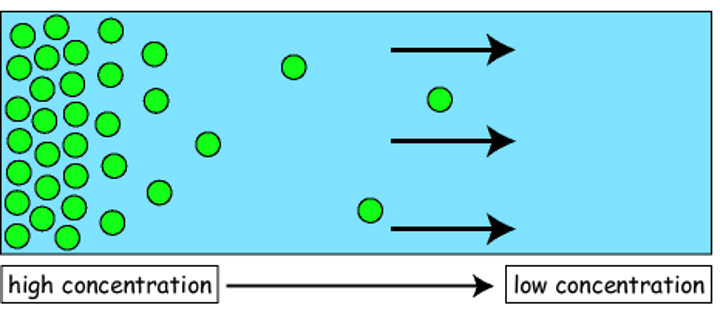
how do we maximize diffusion overall?
1. increase surface area
2. shorten the diffusion distance
3. have a stepper gradient
how do root hairs of a plant root and villi that line the intestine of vertebrates increase the surface area?
increasing surface area to volume ratio will result in more rapid heating and cooling, which may lead to improved quality of how a substance is digested/absorbed
what is bioenergetics (metabolism)?
energy flow through living systems
what is the metabolic rate?
the amount of energy an animal uses in a unit of time (base level to stay alive)
why do ectotherms require much less energy per kilogram than an endotherm of an equivalent size?
endotherms use heat from metabolism for thermoregulation
metabolic rate is proportional to body mass to the power of three quarters which means a small animal has a much greater energy demand per kilogram than a large animal
this is due to a higher surface: volume ratio (small animals lose heat faster)
ectotherms have a much lower metabolic rate than endotherms
what are chemoheterothrophs?
organisms that depend on organic chemicals to generate energy/ATP
they derive their carbon requirements from organic compounds in their environment (food)
what are the 4 stages of food processing in animals?
1. ingestion
2. digestion
3. absorption (transport)
4. elimination
what is ingestion?
the act of eating or feeding
what is digestion?
when food is broken down into small molecules (mechanical or chemical)
what is absorption (transport)?
when cells take up small molecules (and deliver to body cells)
what is elimination?
passing of undigested material out of the digestive system
What are the four basic ways to ingest?
1. substrate feeding- live on the food
2. suspension feeding-
filter and trap food
3. fluid feeding- suck up food
4. bulk feeding- large pieces
what is hydrolysis in the digestive system?
uses water and digestive enzymes to break down complex molecules.
what does dehydration do in digestion?
builds up and requires energy
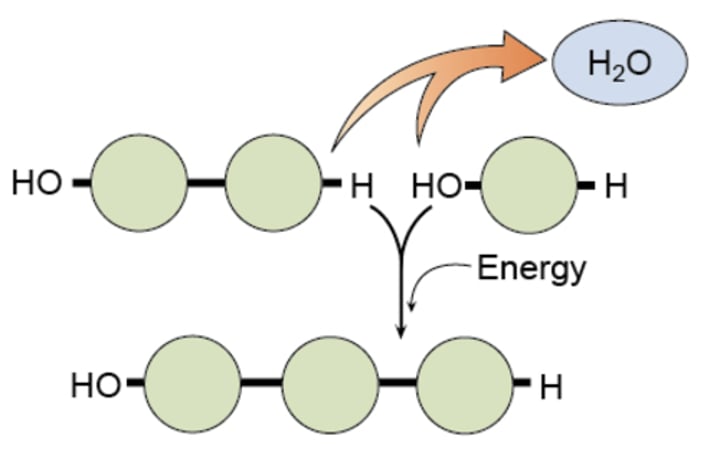
what does hydrolysis do in digestion?
breaks down and releases energy
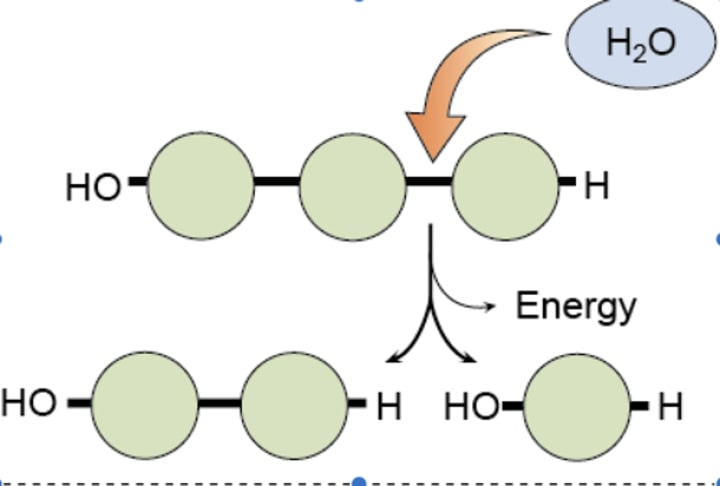
how does chemical digestion occur through hydrolysis?
uses water and digestive enzymes to break down polymers; digestive enzymes speed up the hydrolysis process which is otherwise very slow
what is mechanical digestion?
breaks food into smaller pieces, increasing surface area exposes surfaces to chemical digestion
what's an example of mechanical digestion?
chewing, grinding, stomach churning, peristalsis in the intestines
what is chemical digestion?
cleaves large molecules into smaller molecules (enzymatic hydrolysis)
what's an example of chemical digestion?
saliva, stomach acid, enzymes in the stomach and intestines
when animals make enzymes to break down carbohydrates, proteins, and fats, how does that not break down our cells and tissues?
compartmentalization (process of digestion occurs in different areas)
how do simple body plans eat?
through the gastrovascular cavity which has a singular opening that intakes food and expels waste
example: hydra
how do complex body plans eat?
through the alimentary canal with two separate openings where one intakes food (mouth) and the other expels waste (anus)
example: birds, earthworms, humans
what organs/body parts are part of the mammalian digestive system?
1. mouth
2. esophagus
3. stomach
4. small intestine
5. large intestine
6. rectum
7. anus
accessory:
1. salivary glands
2. gallbladder
3. liver
4. pancreas
where does digestion begin?
the oral cavity (mouth)
what part of the mouth performs mechanical digestion?
teeth and tongue
(increases surface area for enzymatic hydrolysis and facilitates swallowing by forming and pushing back bolus)
what part of the mouth performs chemical digestion?
saliva
how do different enzymes aid in chemical digestion?
1. mucus lubricates food for swallowing and protects gums from abrasion
2. buffers neutralize acids to prevent tooth decay
3. lysozyme kills bacteria on food
4. amylase breaks down starch (plants) and glycogen (animals)
what is peristalsis?
waves of muscular contractions/relaxation in the esophagus that moves the food down the stomach
what part of the stomach performs mechanical digestion?
muscular-contraction-churning
(mixes food with digestive juices to form chyme and moves food into the small intestine via peristalsis)
what part of the stomach performs chemical digestion?
gastric juices
how do different acids aid in chemical digestion?
HCl disrupts the extracellular matrix binding cells together, kills bacteria, and denatures proteins
pepsin breaks down proteins by attacking peptide bonds
why doesn't HCL and pepsin eat through the lining?
pepsinogen is inactive
mucus protects the stomach lining
epithelial cells of the stomach are replaced every 3 days
what is heartburn (acid reflux)?
the backflow of stomach contents into the esophagus
what is the role of the sphincter in the stomach?
regulates food passing from the esophagus into the stomach, and prevents the contents of the stomach from reentering the esophagus
what part of the small intestine performs mechanical digestion?
peristalsis
(moves digested food to the jejunum and ileum)
what part of the small intestine performs chemical digestion?
various enzymes
(most enzymatic hydrolysis happens in the duodenum where it mixes with juices from the pancreas, liver, and gallbladder)
what does the pancreas release to neutralize the acid in the intestines?
sodium bicarbonate
what is the role of the pancreas during digestion?
releases an alkaline solution which neutralizes acid from the chyme
proteases break down proteins
what is the role of the liver during digestion?
makes bile that aids in lipid digestion and red blood cell destruction
detoxifies toxins/drugs
what is the role of the gall bladder during digestion?
stores the bile
what organ(s) does most of the nutrient absorption happen in?
jejunum and ileum
nutrient-rich blood travels directly to the liver via the ___________________________
hepatic portal vein
transport can be passive or active depends on ___________________________
the type of nutrient
what recovers the water and begins in the small intestine?
the colon
what ferments plant material in some animals?
the cecum
how is waste eliminated through the rectum?
1. colon reabsorbs water
2. as water is reabsorbed, feces becomes solid
3. colon bacteria generate stinky gases
4. rectum stores feces until its eliminated
what are some dental adaptations in carnivores?
large, pointed incisors, and canines to kill rip, and cut
jagged premolars and molars crush and shred meat to digest it
what are some dental adaptations in herbivores?
broad and ridged premolars to grind up plants
what are some dental adaptations in omnivores?
incisors for bitings, canines for tearing, premolars for grinding, and molars for crushing
what is the human microbiome?
the collection of microorganisms that live in our bodies
(can contribute to obesity, nutritional deficiencies, diabetes, cardiovascular disease, inflammatory diseases, brain function, and mood)
what is osmoregulation?
how animals control solute (salt, ions, glucose, etc) concentrations in the interstitial fluid and balance water gain and loss
what is osmosis?
the movement of water across a semipermeable membrane
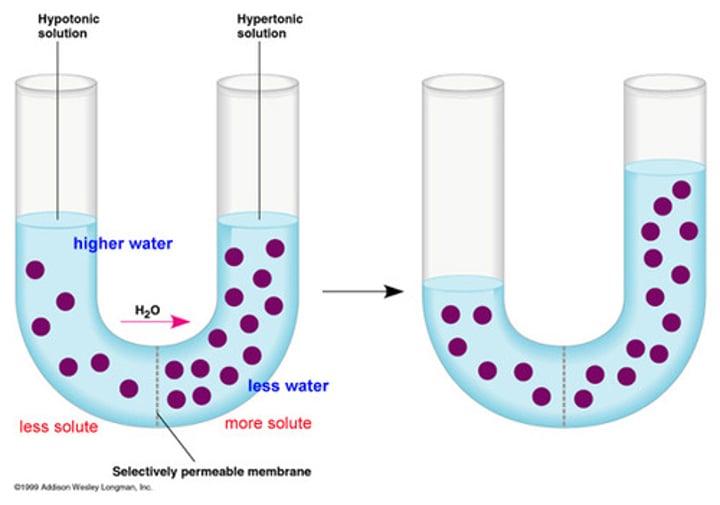
what is osmolarity?
total concentration of solutes in a solution
what is isosmotic solution?
equal solutes on both sides, no net H2O movement
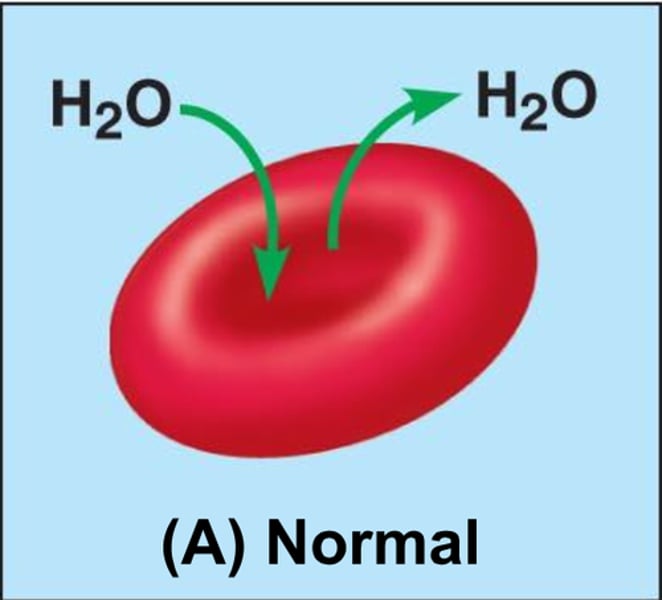
what is a hypotonic solution?
lower solute concentration in solution, H2O moves into the cell

what is a hypertonic solution?
higher solute concentration in solution, H2O moves out of the cell
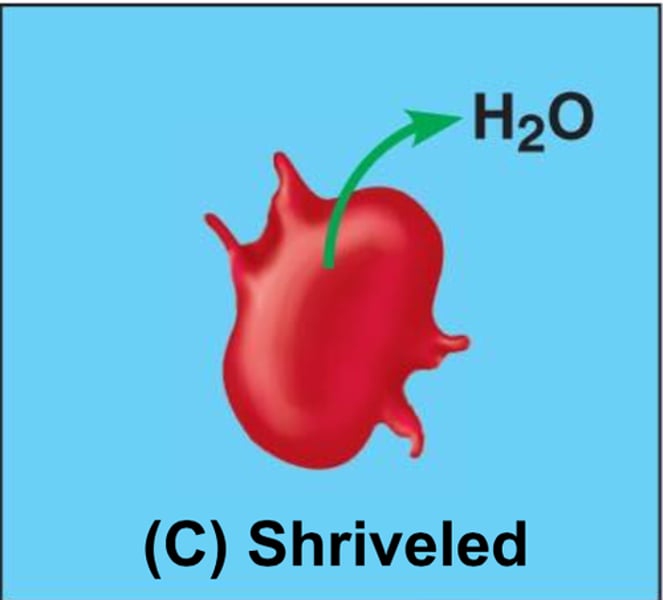
what is an osmoconformer?
isosmotic with its surroundings (osmolarity changes with environment)
less energy expended trying to control osmolarity
what is an osmoregulator?
control internal osmolarity independent of the environment
(more energy-intensive to keep osmolarity in a tightly controlled range.)
characteristics of ammonia waste?
less energy, higher toxicity
characteristics of urea waste?
more energy, lower toxicity
characteristics of uric acid waste?
most energy, lowest toxicity
what is filtration?
water, small solutes, sugars, amino acids, nitrogenous waste, etc.are filtered out of the blood
what is reabsorption?
water and useful solutes (sugars, vitamins, amino acids) are turned to the blood via active transport.
what is secretion?
nonessential solutes or waste are secreted out of the blood via active transport
what is excretion?
filtrate is released from the body
what is a key adaption of excretory processes?
transport epithelia are arranged in complex tubular networks for maximum surface area
vertebrate excretory system
nephrons filter, reabsorb, secrete, and excrete liquid waste
urine from the extensive excretory tubules is passed to the bladder to be excreted
water is going back and forth that makes up the lining of the nephrons and the solute concentration will change based on what your body needs and the environment
what are some adaptations that help conserve water?
loop of henle
(long loops allow for more concentration of urine while short loops cannot concentrate as much urine)